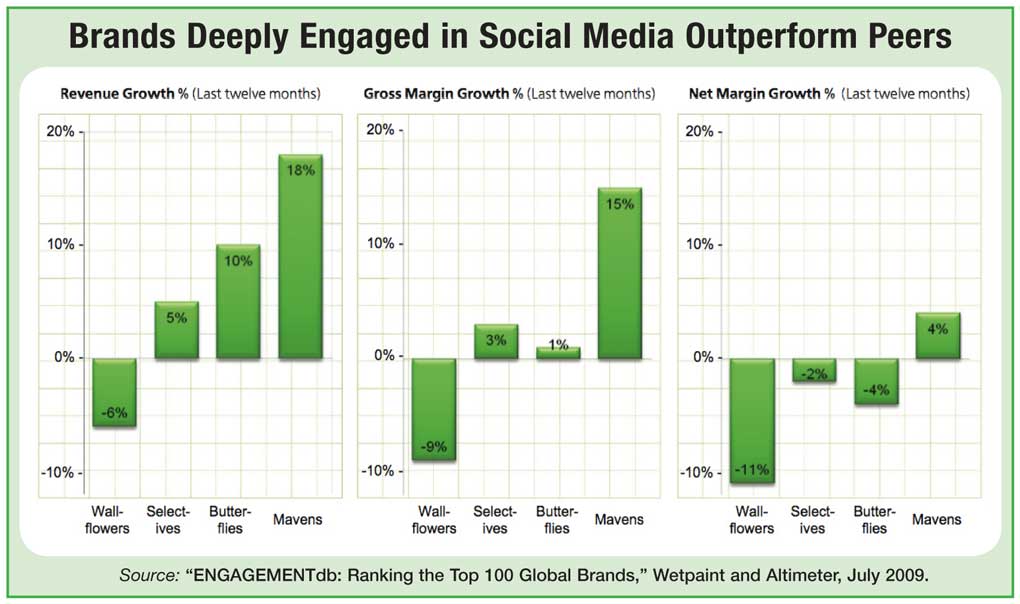The connection between engagement in social media and financial performance has always been assumed by the most forward-thinking brands but, based on a new report from Wetpaint and Altimeter Group, there is now overwhelming evidence supporting a strong correlative relationship.
The report, “ENGAGE-MENTdb: Ranking the Top 100 Global Brands,” takes an analytical approach to measuring the true financial value of social media at the companies that appeared on BusinessWeek / Interbrand’s “Best Global Brands 2008” list. The research team evaluated these companies’ engagement with consumers via social media, placing them in one of four categories based on a number of quantitative and qualitative factors. The engagement profiles are:
• Mavens: Brands that are engaged in seven or more channels and have an above-average engagement score; have a robust strategy and dedicated teams focused on social media; and make it a core part of their go-to-market strategy.
• Butterflies: Brands that are engaging in seven or more channels but have lower-than-average engagement scores; have initiatives in many different channels but tend to spread themselves too thin, investing in a few channels while letting others languish.
• Selectives: Brands that are engaged in six or fewer channels and have higher-than-average engagement scores; have a very strong presence in a few channels, engaging customers deeply when and where it matters most.

• Wallflowers: Brands that are engaged in six or fewer channels and have below-average engagement scores; are testing a few channels; and are cautious of the risks and uncertain of the benefits.
Once the team assigned each company to one of the four engagement profiles, it then analyzed their financial performances against their degree of social media engagement. The conclusion: Companies both deeply and widely engaged in social media surpass their peers, both in terms of revenue and profit performance—by a significant margin.
With that, the following round out the top 10 most engaged brands according to the researchers’ methodology:
1. Starbucks
2. Dell
3. eBay
4. Google
5. Microsoft
6. Thomson Reuters
7. Nike
8. Amazon
9. SAP
10. Intel and Yahoo (tie)
Based on the research findings, then, the team interviewed key executives at the top performers to identify a number of best practices that contributed to their success, such as:
â–¶ Find champions who can explain and mitigate risk. “We had to accept that there were some unknowns,” says Chris Bruzzo, vice president of brand, content and online, Starbucks, in the report. “If you try to mitigate every piece of risk, you will be either inauthentic or fail. There needs to be someone who not only gets social media but can also translate it for the organization.”
â–¶ Make a long-term commitment: “If you are going to engage, you have to have a plan and make sure that resources are available because you can’t gracefully exit—once you’re in, you’re in,” says Denise Morrissey, online community manager of Toyota. “The days of walking away from a campaign are over. Once we engage, we have to commit to it.”
â–¶ Spread engagement to employees beyond the social media team. “There aren’t enough bodies here to engage 24/7,” Morrissey says. “Together with our agency, we put together guidelines and best practices on customer engagement, then communicated and shared the responsibilities with the functional groups who could respond to, for example, environmental news.”
â–¶ Make social media part of the corporate culture. “It’s more like branding—our activities reflect an attitude of the company that is more engaged, a company that values the opinions and viewpoints of the many different voices of customers and suppliers,” says Mark Yolton, senior vice president of SAP’s Community Network. “If we can make our customers more successful, then they will buy more products and services.” PRN
